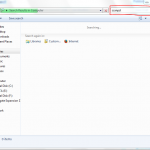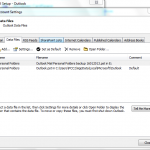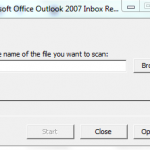Microsoft Outlook is often made unusable because it fails to connect to the Exchange server. Sometimes troubleshooting the issue is as simple as restarting. In other instances though, troubleshooting can appear more challenging… or so it seems.
The following suggestions make solving that connectivity issue a bit easier. They don’t require a computer genius or a geek to understand them, so just about anyone should be able to get Outlook re-connected to their Exchange server. So to start with the simplest tip and we’ll increase the sophistication and effort as we go through them.
Uncheck offline mode
Often I’ll have a customer call and say, “My email won’t work!” You may find that Outlook was somehow set to offline mode. If you’re using Outlook 2007 or earlier, click the File menu. If there is a check mark next to Work Offline, uncheck it, and you should be good to go.
If you’re using Outlook 2010 or higher, follow these steps:
Click the Send/Receive tab.
- Locate the Work Offline button.
- Click the Offline button.
At the bottom of your Outlook window, you should see Trying To Connect. Hopefully it will then connect and you are sorted, easy as that.
Restart
As I noted above you can try restarting both the computer and or Outlook. The age old resolution of reboot the (restarting) the system can reset all of the services and as if by magic everything begins to work. The issue could be caused by the computer having connectivity issues. If you open your web browser and cannot reach a website or internal resources, that’s most likely the problem.
If Outlook still wont connect and you cannot reach any websites then it may be time to call me, because you probably have a networking issue. this will need to be looked into to see if it’s local (just you/your machine) or if it’s a wider issue.
Rebuild
Outlook uses two types of data files (.pst and .ost), and both are susceptible to errors that can cause connectivity problems. Here’s how I handle this:
Close Outlook.
- Open the Control Panel.
- Locate the Mail icon (depending on how Windows Explorer is set up, you might have to click the Users section to find the Mail icon).
- In the resulting window, click Data Files.
- Select your data file from the list and click Open File Location (Figure A).
- Locate the data file in question (it will probably have the same name as your email address).
- If the file has the extension .ost, rename the extension to .OLD. If the file has the extension .pst, do nothing at this time.
- Close these windows and open Outlook.
Figure A
This window will list all data files in use with Outlook. You need to know the file type in order to know if your data file is a .pst or .ost. You can do this through Windows Explorer settings. If your data file is a “.pst”, follow these steps to run Scanpst on the file:
- Search for scanpst.exe through Windows Explorer.

- After you locate the file (e.g., a location could be C:\Program Files\Microsoft Office\Office14\), double click to run the application.
- From the resulting window, click Browse (Figure B).
- Locate your .pst file.
- Click Start.
Figure B
If you’ve run Scanpst on your data file before, the location will already be in the field.
This will will run eight passes over the data file; depending on the size of your data file, this may take a little time. If Scanpst finds errors in the data file, you will be prompted to click the Repair button. It’s also worth ticking the box for “Make Backup Of Scanned File” just in case something goes awry.
After the repair has finished, close Scanpst and re-open Outlook. If you still cannot connect, move on to the next tip.
Repair install
You can run a repair installation of Microsoft Office; this will solve problems that standard fixes cannot repair. To do this, follow these steps:
Open the Control Panel.
- Click Programs and Features.
- Locate the entry for your Microsoft Office installation and select it.
- Click Change.
- Select Repair from the resulting window.
- Click Continue.
- Allow the repair to complete.
- Reboot your computer.
After your computer has rebooted, start Outlook and cross your fingers.
Recreate your profile
If nothing else works you can recreate your Outlook profile. To create a new profile (without deleting the old one) — just in case. In order to recreate your profile, you need to know your account settings, so make sure you know and have that information before you begin. Here’s how to create a new profile:
Open the Control Panel.
- Open Mail.
- Click Show Profiles.
- Click Add (Figure C).
- Give the profile a name.
- Walk through the Outlook account setup wizard.
- Once the profile is known to work, you may want to set that profile up as the default.
- For the time being do not delete the old profile as there may be things in there that you need or want even if it wont connect.
If after all of these steps Outlook is still unable to connect, it’s time to call for extra help.The likely cause now lie outside user ability to influence or correct and are not part of this particular post.
Thank you for reading and good luck.



